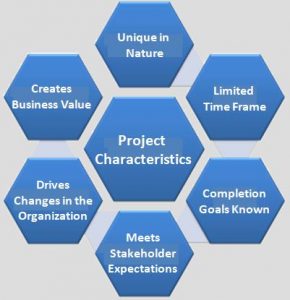Determine whether a given endeavor is a Project? or not?
Before going into the definition of a project, let’s start with an example of how projects come about.
Consider a scenario like: You work for a wireless phone provider, and the VP of marketing approaches you with a fabulous idea – “fabulous” because he’s the big boss and because he thought it up.
He wants to set up kiosks in local grocery stores as mini-offices. These offices will offer customers the ability to sign up for new wireless phone services, make their wireless phone bill payments, and purchase equipment and accessories.
He believes that the exposure in grocery stores will increase awareness of the company’s offerings. After all, everyone has to eat, right? He tells you that the board of directors has already cleared the project, and he’ll dedicate as many resources to this as he can. He wants the new kiosks in place in 12 stores by the end of this year.
The best part is that he has assigned you to head up this project.
The very first question that must be in your mind should be; “Is it a project?”
This might seem elementary, but projects are generally confused with ongoing operations.

# Projects are temporary in nature;
# Projects have definite start and end dates;
# Projects produce a unique product, service, or result;
# Projects are completed when their goals and objectives have been met and signed off by the stakeholders or when the project is terminated.
# Projects generally initiate change in an organization by moving the business from one state to another. For example, when an organization undergoes a new back office software implementation or upgrade, changes will occur within the organization to accommodate the new business process and software. The business moves from current state – where they are now – to future state – where they will be once the software is implemented.
# Lastly, projects also bring about business value creation. Business value can be tangible (revenue, goods, market share) or intangible (goodwill, recognition, public benefit).
When considering whether you have a project on your hands, you need to keep some issues in mind.
1) Is it a project or an ongoing operation?
2) If it is a project, who are the stakeholders?
3) What characteristics distinguish this assignment as a project?
Projects vs. Operations:
Projects are temporary in nature and have definitive start dates and definitive end dates. The project is completed when its goals and objectives are accomplished (by producing deliverables) to the satisfaction of the stakeholders. Sometimes projects end when it’s determined that the goals and objectives cannot be accomplished or when the product, service, or result of the project is no longer needed and the project is cancelled. Projects exist to bring about a product, service, or result that didn’t exist before. This might include tangible products, components of other products, services such as consulting or project management, and business functions that support the organization. Projects might also produce a result or an outcome, such as a document that details the findings of a research study. In this sense, a project is unique.
However, don’t be confused by the term unique. For example, Ford Motor Company is in the business of designing and assembling cars. Each model that Ford designs and produces can be considered a project. The models differ from each other in their features and are marketed to people with various needs.
An SUV serves a different purpose and clientele than a luxury sedan or a hybrid. The initial design and marketing of these three models are unique projects. However, the actual assembly of the cars is considered an operation – a repetitive process that is followed for most makes and models.
Determining the characteristics and features of the different car models is carried out through progressive elaboration. This means the characteristics of the product, service, or result of the project are determined incrementally and are continually refined and worked out in detail as the project progresses. More information and better estimates become available the further you progress in the project.
Progressive elaboration improves the project team’s ability to manage greater levels of detail and allows for the inevitable change that occurs throughout a project’s lifecycle. This concept goes along with the temporary and unique aspects of a project because when you first start the project, you don’t know all the minute details of the end product. Product characteristics typically start out broad-based at the beginning of the project and are progressively elaborated into more and more detail over time until they are complete and finalized.
Project Characteristics:
The project can have several characteristics, that can be identified through the following criteria;
1) Projects are unique.
2) Projects are temporary in nature and have a definite beginning and ending date.
3) Projects are completed when the project goals are achieved or it’s determined the project is no longer viable.
4) A successful project is one that meets the expectations of your stakeholders.
5) Projects initiate change in the organization.
6) Projects bring about business value creation.
Using these criteria, let’s examine the assignment to set up kiosks in local grocery stores as mini offices to determine whether it is a project:
Question-1: Is it unique?
Yes, because the kiosks don’t exist now in the local grocery stores. This is a new way of offering the company’s services to its customer base. Although the service the company is offering isn’t new, the way it is presenting its services is.
Question-2: Does the project have a limited time frame?
Yes, the start date of this project is today, and the end date is the end of this year. It is a temporary endeavor.
Question-3: Is there a way to determine when the project is completed?
Yes, the kiosks will be installed, and services will be offered from them. Once all the kiosks are intact and operating, the project will come to a close.
Question-4: Is there a way to determine stakeholder satisfaction?
Yes, the expectations of the stakeholders will be documented in the form of deliverables and requirements during the Planning processes. Some of the requirements the VP noted are that customers can sign up for new services, pay their bills, and purchase equipment and accessories. These deliverables and requirements will be compared to the finished product to determine whether it meets the expectations of the stakeholders.
Question-5: Is it driving change?
Yes, this is a new way of doing business and providing service to our customers.
Question-6: Will business value creation be realized?
Yes, this project will hopefully improve market share, increase revenues, produce goodwill among our customers, create more brand recognition, and drive up shareholder equity.
Conclusion:
Projects may be terminated due to any of the following reasons.
1) The objectives have been met,
2) The objectives cannot be met,
3) Funding is no longer available or was spent,
4) The project is no longer needed, or
5) The project was terminated due to legal reasons or any other inconvenience.
All Articles on PMP Certification and Project Management
Largest Database of PMP Exam Preparation Question Papers

An expert on R&D, Online Training and Publishing. He is M.Tech. (Honours) and is a part of the STG team since inception.
